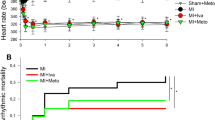Summary
We investigated the antiarrhythmic effects of bidisomide (SC-40230), a new class I antiarrhythmic drug, in early-phase ventricular arrhythmias induced by coronary artery occlusion and reperfusion in anesthetized rats. The effects of bidisomide were compared with those of mexiletine (MXT) and disopyramide (DSP), established class I antiarrhythmic drugs. Drugs were administered intravenously, 5 min before induction of coronary occlusion. Bidisomide (5 mg/kg) reduced the number of premature ventricular complexes and the incidence of ventricular tachycardia and ventricular fibrillation similarly to MXT and DSP in rats with ventricular arrhythmias induced by coronary artery occlusion. In rats with ventricular arrhythmias induced by coronary artery reperfusion following a 5min coronary occlusion, the antiarrhythmic effects of 5 mg/kg of bidisomide were similar to those of the same doses of MXT and DSP. All three drugs significantly slowed the heart rate. Our results suggest that bidisomide may effectively reduce the severity of lifethreatening ventricular arrhythmias that occur during acute coronary syndrome.
Similar content being viewed by others
References
Martin CL, Borowicz LE, Schniepp HC, Sanguinetti MC (1989) Voltage- and rate-dependent reduction of Vmax of cardiac action potential by SC-40230. Drug Dev Res 17:51–61
Garthwaite SM, Frederick L, Cook C, Hatley F (1992) Electropharmacology of bidisomide in the normal intact canine heart. Drug Dev Res 27:329–344
Frederick LG, McDonald SJ, Garthwaite SM (1989) Cardiovascular profile of a new anti-arrhythmic agent, SC-40230. Cardiovasc Res 23:897–903
Hashimoto K, Satoh H, Shibuya T, Imai S (1982) Canineeffective plasma concentrations of antiarrhythmic drugs on two-stage coronary ligation arrhythmia. J Pharmacol Exp Ther 223:801–810
Lazzara R, El-Sherif N, Hope RR, Scherlag BJ (1978) Ventricular arrhythmias and electrophysiological consequences of myocardial ischemia and infarction. Circ Res 42:740–749
Marshall RJ, Muir AW, Winslow E (1981) A comparison of the intensity and duration of the antidysrhythmic effect of mexiletine and Org 6001 in anaesthetised rats. Br J Pharmacol. 74:381–388
Han J, Goel BD, Yoon MS, Rodgers R (1974) Effects of procainamide and lidocaine on ventricular automaticity and re-entry during acute coronary occlusion. Am J Cardiol 34:171–178
Marshall RJ, Winslow E (1982) The effects of sodium channel inhibitors on early arrhythmias associated with acute myocardial ischaemia. In: Parratt JR (eds) Early arrhythmias resulting from myocardial ischaemia. Macmillan, London, pp 251–294
Clark C, Foreman MI, Kane KA, McDonald FM, Parratt JR (1980) Coronary artery ligation in anaesthetised rats as a method for the production of experimental dysrhythmias and for the determination of infarct size. J Pharmacol Methods 3:357–368
Wu ZJ, Awaji T, Hirasawa A, Hashimoto K (1993) Effects of a new class 1 antiarrhythmic drug, bidisomide, on canine ventricular arrhythmia models. Mol Cell Biochem 119:159–169
Garthwaite SM, Hatley F, Frederick L, Ruby J, Cook C (1989) Effects of SC-40230, a new class 1 antiarrhythmic agent, on canine ventricular tachycardias. Drug Dev Res 17:119–133
Garthwaite S, Frederick L, Hatley F, Hackett A, Ruby J (1989) SC-40230, a new antiarrhythmic, prevents reinduction of malignant arrhythmias in dogs. FASEB J 3:A1020
Parratt JR (1982) Inhibitors of the slow calcium current and earrly ventricular arrhythmias. In: Parratt JR (eds) Early arrhythmias resulting from myocardial ischaemia. Macmillan, London, pp 329–346
Cobb LA, Baum RS, Alvarez H, Schaffer WA (1975) Resuscitation from out-of-hospital ventricular fibrillation: 4-year follow-up. Circulation 51/52 [Suppl II]:223–228
Janse MJ, Capelle FJL, van Morsink H, Kleber AG, Wilms-Schopman F, Cardial R, Naumann d'Alnoncourt C, Durrer D (1980) Flow of injury current and patterns of excitation during early ventricular arrhythmias in acute regional myocardial ischemia in isolated porcine and canine hearts. Circ Res 47:151–165
Vaughan Williams EM (1979) Characterization of new antiarrhythmic drugs. Progr Pharmacol 2:13–24
Author information
Authors and Affiliations
Rights and permissions
About this article
Cite this article
Komori, S., Sano, S., Li, B.H. et al. Effects of bidisomide (SC-40230), a new class I antiarrhythmic agent, on ventricular arrhythmias induced by coronary artery occlusion and reperfusion in anesthetized rats; comparison with mexiletine and disopyramide. Heart Vessels 10, 7–11 (1995). https://doi.org/10.1007/BF01745072
Received:
Revised:
Accepted:
Issue Date:
DOI: https://doi.org/10.1007/BF01745072




